Mark - or anyone else with an onion fetish oops, I mean a deep and encompassing knowledge of the genus Allium ;D ;) - could you please tell me what the heck I planted here?
It has very unusual leaves for an allium - reminiscent of lily-of-the-valley, particularly in the earlier stages. (Pardon all the frost damage on the leaves in my pix). The flower stems are 22" to 28" tall. The flowers are a rather gray-white, with dusky grayish pink on the backsides of the petals and on the individual little stems of the umbel. My wildest guess... Allium victorialis??? (Hmm, I remember trying seeds years ago... could it be? Or did I buy it? Sheesh, I thought amnesia only happened in soap operas!)
Please, help to clear up my confusion! Thanks in advance for sharing your expertise!
Comments
Re: Mysterious allium...
Where is that old Mark when you neeed him? I'm sure he will chime in with the correct ID. I google imaged Allium victorialis and it looks reasonable. I was going to suggest Allium tulipifolia, but couldn't find pix. I remember seeing the foliage in Kazakhstan last year and it looked similar.
I don't know if I am a fetishist exactly (and can't hold a candle to Mark in the alliaceous dept.) but I seem to grow more and more onions as time goes on..
Re: Mysterious allium...
I think all of us eventually gravitate toward allium. There's just something about them--and their reliability. I've got a few species blooming in the new gardens now. If you pick your species carefully, you can have quite a long season of interest.
Re: Mysterious allium...
Lori, your mystery Allium is A. ovalifolium, a diverse Chinese species; I am quite certain of the ID. I can see where everyone was guessing A. victorialis, that species is among about 5-6 in China and elsewhere that have broad leaves with distinct leaf petioles, the foliage doing a fair impersonation of Lily-of-the-Valley (Convallaria) or even imitating Hosta leaves, in fact there is a Chinese species named Allium funckiifolium (funkia, the old name for Hosta).
With Allium victorialis, which I grow in several forms, the flowers are never truly white, they are more of an ochroleucus yellowish or greenish white, and they don't have any lavender or pink tinge. It is one of my favorite species. Trond, the photo link to emerging foliage of A. victorialis shows how beautiful the leaves are when emerging.
There are 3 subspecies of A. ovalifolium, although only A. ovalifolium var. leuconeurum is distinct in my opinion, this form has narrower leaves but with a conspicuous white midvein done each leaf. I used to grow it, although it is long gone now. The other two varieties; var. ovalifolium and var. cordifolium, are poorly defined and cover such variability, that one can grow plants impossible to assign to either variety... so I just call such things Allium ovalifolium.
Allium ovalifolium in Flora of China:
http://www.efloras.org/florataxon.aspx?flora_id=2&taxon_id=200027510
In the species description, the flowers are described as "white, rarely pale red", but be aware that the Chinese language, at least as it is used botanically, or perhaps an issue with translation, does not have an equivalent of pink or lavender, and all such colors get described as "pale red". In my experience with A. ovalifolium, there is often a pink or lavender blush to the white flowers. Lori, your plant is a very nice form by the way... foliage-wise and flower-tepal shape, it seems to be closest to A. ovalifolium var. ovalifolium. Most forms I've seen photos of on the web, resemble you plant closely. Lori, if you get any seed... wink, wink.
I am showing a few very poor photos of A. ovalifolium that I'm growing. It has all white flowers with acuminate tepals, thus should be var. cordifolium, except the foliage doesn't match var. cordifolium at all, so I just call it A. ovalifolium. In the seven years I've grown it, there's been no increase, still just a single bulb. I got this plant as A. aciphyllum from Chen Yi 7 years ago (my first and last order to that "business"), and what came out of it were two different Allium species, this one and the red-flowered Allium prattii, which you can see in one of the photos... it has more lanceolate strap-shaped leaves. The reason both species are growing so close together in my garden, this was supposed to be just one species! I will post some new pics of A. prattii in the Allium 2010 thread, my plant has increased and flowered well (both flowering now, although A. ovalifolium didn't flower well this year, thus not photogenic).
The one I'm most taken with, is the Chinese A. listera, one that does an excellent imitation of a Hosta in the foliage department. I grow three forms, collected by Darrell Probst, only two are flowering. Here again, I'll post photos to the Allium 2010 thread.
Re: Mysterious allium...
Huh, now where the heck did I get that from?!? ;D
Thanks to everyone for their help, and especially to Mark for sharing his incredibly encyclopedic knowledge! (You are astounding! :o)
Before I start browsing the link and rereading to absorb the text, I just wanted to say that I will definitely collect and make seed available... inshallah. :)
Re: Mysterious allium...
Great Lori....if you have any extra, I would like to give them a try. I have a bit of an onion fetish myself! I have never had luck getting victorialis or any other of the broad-leaved alliums to germinate....is there a trick Mark?
Re: Mysterious allium...
Great Lori....if you have any extra, I would like to give them a try. I have a bit of an onion fetish myself! I have never had luck getting victorialis or any other of the broad-leaved alliums to germinate....is there a trick Mark?
Allium victorialis species requires winter stratification to germinate, but I'm wondering if it also needs lots of moisture to germinate too. I've grown a form for 20+ years and it rarely would show self-sown seedlings, although in the last few years many self-sown seedlings appear. It grows in a low spot that is actually under running water and spring seepage... later becoming drier in summer. About 7 years ago I introduced two named selections from Pacific Rim Nursery, ones named 'Kamerovo' and 'Cantabria'. Both of these are upright growing forms, with stems nearly standing to 3' (1 meter) in flower and handsome long and wide foliage, 'Kamerovo' with red-centered pedicels, and 'Cantabria' with really large heads of bloom. Not sure if because I have different clones or what, but they are now seeding around quite a bit... but no need to worry, they take years to reach mature flowering size, and are not that prolific.
Your message reminded me that seed is ready to harvest, will do so tomorrow... supposed to be only 98 F tomorrow instead of the 99 F it reached today ;D Happy to share some seed. Uploaded are photos of both forms and seed ripe heads on 'Kamerovo', still green capsules on 'Cantabria'.

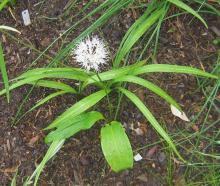
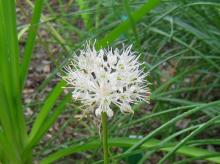
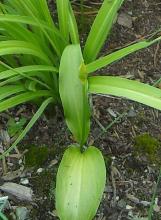
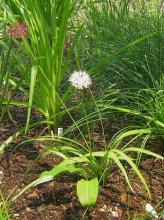
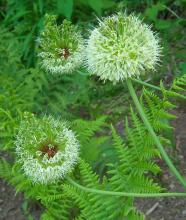
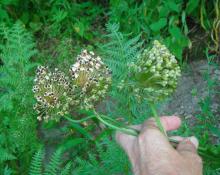
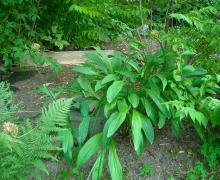
I would say it seems to be Allium victorialis, but I am no onion expert! It is commonly grown in Northern Norway. Here's the leaves in spring:
http://www.stewo.no/A/Allium%20victorialis%2015.jpg